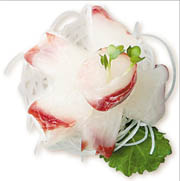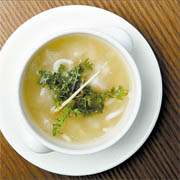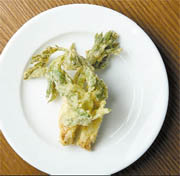Seafood, greens are Korean spring treats

chamnamul (dropwort).
Like any food, the best ingredients are seasonal.
In a widely-read cartoon about Korean food “Sikgaek” (Korean for “food for guests) a chef brags at length in a chapter about an autumn gizzard shad.
“We have a right to feed seasonal harvests and ingredients when their existence shines at the fullest,” he says. A celebrity Italian chef of the Michelin Guide also told me recently that the true value of his food is “a fresh flavor from using seasonal ingredients of Tuscany.”
In the Korean springtime, nothing beats the taste of fresh sprouts and wholesome sea creatures that are ready to lay eggs. These range from trout to ground dropwort, small octopuses to fatsia buds. Here are some of most beloved spring greens and seafood that are eaten in the spring in Korea.

Naengi (horseradish)and crabmeat soup is a popular spring dish in Korea. [JoongAng Ilbo]
Chamnamul (dropwort): Chamnamul is eaten in the spring and early summer as a vegetable wrapping for rice and meat. You could also broil it and season it with a small pinch of salt and sesame oil to eat with rice. It’s fragrant, and many Koreans eat chamnamul to stimulate appetite. It’s also used to make kimchi.

Deep-fried dureup.
Yuchae (rape): The best time to eat rape is March and April before it blooms. It’s rich in vitamins and exudes a sweet and bitter taste when you chew it. To eat, rinse thoroughly in water, lightly broil and season with sesame seed, crushed garlic, diced green onion and sesame oil. Another common recipe is to season it with soybean paste.
Trout: In “Fishes of the Huksan Island,” a famous book by a Joseon scholar that chronicles sea creatures living in Huksan Island, the author picks trout as the best fish ever. Trout was used as a medicine to soothe the stomach and intestines. It’s best eaten from October to February.
Red snapper: Red snapper was long considered a precious fish served locally during important events like weddings or parties. It’s got high protein and low fat, and is most eaten in March and April before snappers lay eggs. Some of the best spring seafood include scallops, clams, dried seaweed and baby octopus.
Several restaurants in Seoul offer menus using fresh spring vegetables. Sanchaejip (02-754-1978), a restaurant in Namsan just below the cable car, offers a set meal of spring vegetables and broiled meat and rice mixed with spring vegetables. Asiate (02-2018-0906) in Gangnam Station offers a salad of sprouts and beef brisket. The Parkview in the Shilla Seoul holds a promotion of spring food through March 31.
Lunch is 49,000 won ($48.80) and dinner is 53,000 won.
For information call (02) 2230-3374.
By Seo Jeong-min JoongAng Ilbo [myfeast@joongang.co.kr]










with the Korea JoongAng Daily
To write comments, please log in to one of the accounts.
Standards Board Policy (0/250자)